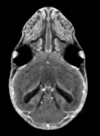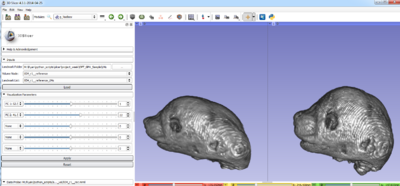2014 Summer Project Week:Slicer Murin Shape Analysis
From NAMIC Wiki
Home < 2014 Summer Project Week:Slicer Murin Shape Analysis
Research: Changes in development due to Fetal Alcohol Exposure and how this affects the development of the craniofacial complex.
Modalities: Optical Projection Tomography File:Sample OPT Mouse embryo.zip
Micro Computed Tomography File:Stained registered sample mCT.zip


Shape Analysis
Challenges in Slicer with our datasets due to small voxel sizes (6-35 micron). Specifically visualization, recording coordinates of anatomical landmarks, segmentation and registration. (File:Project week question.txt)
Goals for Project Week:
Key Investigators
- Murat Maga (Seattle Children's Research Institute & University of Washington Dept. of Pediatrics)
- Ryan Young (Seattle Children's Research Institute)
Project Description
- Face is the major diagnostic feature to identify
- Brain and the CNS are affected primarily.
- What's the earliest time we begin to detect changes in the face?
- How does the brain volumes (and gross morphology) relate to changes in the face?
Micro Computed Tomography File:Stained registered sample mCT.zip


- Meet the community and learn from them!
- Raise awareness about issues in using Slicer in high-resolution small animal imaging.
- Implement the landmark based Procrustes Analysis in Slicer
Objective
- Create a GPA/PCA shape analysis and visualization module for Slicer.
Approach, Plan
- Implement GPA/PCA shape analysis in python
- Provide an interactive tool to visualize the decomposition along the principle components of shape variation using thin plate splines.
 )
) - Ability to create semi-landmarks to increase coverage in regions where anatomial landmarks are sparse.
- User will a uniformly sampled point cloud by entering the number of semi-landmarks. Existing “hard” landmarks will be used for their distribution. This will serve as the template to be transferred to all remaining volumes (atlas)
- The template will be transferred to a new surface. Existing “hard” landmarks will allow for correspondence. The transferred points will then be moved along the surface of the volume by optimizing the bending energy function.
- The coordinates of the slid landmarks will be saved into a new fiducial list, from which the GPA analysis can be conducted.
- These should be accomplished on volume, not surface meshes derived from scans.
Progress
- Generalized Procrustes Alignment (implemented)
- Principal Component and Singular Value Decomposition of the Procrustes aligned coordinates (implemented)
- Thin Plate Spline visualization of the shape variables from PCA and/or SVD (implemented).
- Transfering and sliding a template of semi-landmarks to the target volume (in progress)
